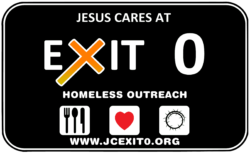Homeless Coalition of Southern Indiana secures severe weather shelter site

Temporary shelter would shield people from harsh weather
NEW ALBANY — After several months of planning, the Homeless Coalition of Southern Indiana has secured an initial site for temporary shelter during harsh weather, but is still in grave need of volunteers.
The coalition recently got confirmation from the Salvation Army on Green Valley Road in new Albany that the organization can be the first to help house people who seek shelter during harsh weather.
“We are incredibly grateful that [Salvation Army leaders] saw the need, saw that we were struggling to build this and knew we had to have a place, because it’s going to get cold,” Dawn Klemm, executive director of the Homeless Coalition of Southern Indiana, said.
Klemm has been working with coalition committee volunteers and speaking with community leaders about helping institute a system for “white flag” nights.
White flag status is generally called in areas that have established shelters. It means they open their doors for more people and may lower restrictions on entering. In winter, the status is initiated at 35 degrees or below.
In Southern Indiana, where there is only one shelter, in Jeffersonville, Klemm said the homeless and even those at risk of being homeless need to know they have a safe, warm place to go during harsh weather.
She has been working with the community to secure sites and volunteers who would alternate their time on nights when white flag is called.
She said the white flag temporary shelters will serve anyone who needs it — not only the traditional street-homeless people.
“There are people from that population that we will serve, but there are also people are kind of at risk of being homeless,” she said. “For instance, they’re in an apartment, but they cant afford to keep the heat on. If they run their bill up and they won’t be able to pay their rent and if they don’t pay their rent they can be evicted.
“We’re there to help provide relief for people who need it in the cold weather. We’re not going to be verifying homelessness or anything, if you come to the shelter, we’re going to serve you”
Although Klemm’s projected start date was mid-November, she couldn’t get it off the ground without a site to start. Since the Salvation Army has stepped up, the system will launch Monday. Dec. 12.
At first, the organization will have what Salvation Army director of housing Leslie Cairo calls “an abbreviated opening.” Since the organization has so many things booked through the end of the year that requires the use of the gymnasium, like the Angel Tree, the temporary shelter will initially be held in the house that serves as office space for the Salvation Army.
This initial opening, he said, will be able to house and serve about 10 people. When the main site is opened up after the first of the year, they can house about 50.
“What we really need right now are teams,” Cairo said, who also serves on the Homeless Coalition Board and the white flag committee. “We have the facility but we have to have teams in place in order to staff the white flag.”
Although the coalition has some smaller teams in place through the end of the year, Klemm said they need teams of volunteers for when the temporary shelter is opened up to larger populations in 2017. This includes volunteers to help with food preparation as well as monitoring the site.
“The training is great,” Klemm said. “We have a curriculum lined up of professionals to EMS to the police department, LifeSpring, the VA hospital, it’s a pretty nice curriculum of people who are going to come in and talk about anything we may run across by service.”
Though the Salvation Army is on board through the next few months, Klemm is still looking to add more sites.
“We are still trying to recruit,” she said. “If a church steps forward, we’ll make a shift in the plan.”
Parts of the plan are based off of a 15-site system in place in Chicago for the past two decades, called South Suburban Pads. Klemm recently visited some of the shelters within the system.
“I was so surprised at how well this went down,” she said. “Because once you get something in place that’s systematic, it works like a well-oiled machine.
“The reason we looked at this model is we knew we weren’t prepared to take on a physical shelter building in these communities, but what we wanted to do was try and address the issue from a community standpoint.”
